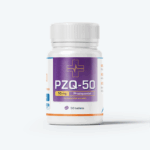-
1× $170.00
-
2× $55.00
-
1× $80.00
Subtotal: $360.00

Original price was: $111.00.$99.00Current price is: $99.00.
Praziquantel PZQ-50
50 Praziquantel Tablets
Composition – 50 mg Praziquantel per dispersible oral tablet
Indications – Anti parasitic, anti cancer
Dosage – Use as directed
Elevated Healing presents PZQ-50, an FDA-approved anti-parasite drug which causes spastic paralysis of parasitic worm musculature related to a fast calcium ion influx into the worm’s tissues. It is also understood that Praziquantel inhibits cellular division in colon (DLD-1) and lung (H1299) cancer cells by down regulating the apoptosis protein XIAP.
Praziquantel is effective on a wide range of fluke and tapeworm species, and is used to treat infections by: Schistosomas, Clonorchis sinensis (small Chinese fluke), Opisthorchis viverrini (Southeast Asian liver fluke), Heterophyes heterophyes (intestinal fluke), Fasciolopsis buski (intestinal fluke), Paragonimus westermani (lung fluke). Human pathogenic tapeworms including: Taenia saginata (beef tapeworm), T. solium (pork tapeworm), Dipylidium caninum (tapeworm in cats and dogs), Hymenolepsis nana (dwarf tapeworm), and Diphyllobothrium latum (fish tapeworm).
Of specific interest is that the Liver flukes, Opisthorchis viverrini, is distinct among helminth infections because it drives a chronic inflammatory response in the intrahepatic bile duct that progresses from advanced periductal fibrosis to cholangiocarcinoma which has one of the highest mortality rates of any cancer.
PLEASE NOTE: the administration of PZQ-50 with a high-fat meal greatly increases its bioavailability. Consume your dose 5-10 mins prior to a meal.
| Dosage | 50mg |
|---|---|
| Tablets | 50 |
| Contents | Medicinal Ingredients: Non-Medicinal Ingredients: |
| Presentation | Medicinal Ingredients: |